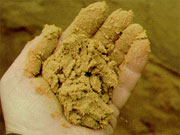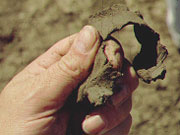Soil Texture
Principal Binding Agents | Soil Texture | Dispersion | Slaking | Dispersion Animation
What is soil texture?
Soil texture is the "feel" of the soil when a moist quantity is manipulated between thumb and forefinger. It is one of the more useful test in evaluating soil.
Some soils are sticky, others will not stick together at all, and others feel "doughy" or "spongy". Some can be manipulated like plasticine. These differences in properties gave rise, in agriculture, to soils being called clays, loams or sands. Clays stick to your boots, loams are easily moulded but non-sticky, sands are not cohesive at all and cannot be moulded when moist.
There are 19 grades of texture that can be simplified into six major groups: Sands, Sandy Loams, Loams, Clay Loams, Light Clays and Medium to Heavy Clays. These texture differences are the result of fineness or coarseness of particles in the soil. A given texture will have a definable range of clay (i.e. < 0.002 mm), silt (i.e. 0.002 - 0.02 mm) and sand (i.e. 0.02 - 2 mm). A special triangular graph is available where texture can be related to likely clay%, silt% and sand%
The effect of particle size
The relative size of particles is important. For example, the finest sand particles are 10 times the diameter of the largest clay particles. The surface area of a spherical particle 0.02 mm diameter is 100 times greater than a spherical particle of 0.002 mm diameter. Clays have an even greater surface area than spherical particles are they are made up of sheet-like structures stacked together. This difference in surface area contributes to the differences in adhesion and cohesion of the texture groups.
How do sands, loams and clays behave?
| Sands because of their large grain size allow faster permeability of water than clays. The disadvantages of sands are that they hold very little water that would be available to plants and have no ability to hold onto plant nutrients in the way that clays do. Loam soils contain sand, silt and clay in such proportions that stickyness and non-adhesiveness are in balance - so the soils are mouldable but not sticky. Loams are the "friendliest" soils to cultivate. |  A example of Loamy Sand | |
| Clays can absorb and hold onto large amounts of water because of their sheet structure and large surface area. This property causes the swelling and shrinking of clay soils as they wet and dry. Clays are therefore also important in generating cracks in soil through which roots can easily pass. Of course, when clays are wet and swollen soil drainage is affected and water cannot pass freely. The surfaces and edges of the sheet structure of clay particles carry negative and positive charges. Elements such as Potassium, Calcium and Magnesium are held on these charged surfaces and can be taken up in solution by plant roots. Clays therefore play an important role in soil fertility. |  An example of Heavy clay |
How moist soil feels when manipulated in the hand is influenced by how much sand, silt or clay is in the sample, and also soil components such as organic matter.
| Clay type | Clay mineralogy affects tractability. Montmorillonite is very fine and encourages ribboning. Kaolinite is very coarse and will inhibit ribboning |
| Organic matter | Cohesion of sandy textures and greasiness of clays |
| Oxides | Cementation (Al & Fe) masks fine textures |
| Carbonates | Cohesion in sands and loams, but inhibits ribboning in clays |
Organic matter is an important contributor to soil texture and helps to ameliorate stickiness and also helps sandy soils hang together, making them feel more loamy.
What properties does soil texture influence
Soil structure
- Soil strength
- Soil aggregation
- Friability, tillage and trafficability
- Drainage and infiltration
- Cation exchange properties
- Plant available water
- Organic matter and carbon retention
The texture of soil is considered a “fixed” property. Thus for land managers, changing the texture of the soil is not a viable option.
However clay delving is one exception where clay from the subsoil is mixed with the sandy surface soil. Clay delving is used in the Mallee and in parts of Western Australia.
Texture often changes between horizons of the soil profile. It is important to recognizes these changes in the soil profile. Many soils have loamy surface soils and heavy clay subsoils. This arrangement controls the movement of water through the profile; the clay restricting downward drainage and encouraging water movement along the top of the restricting layer. Waterlogging of the surface soil can result, even though the subsoil may not be saturated.
Assessment of soil texture?
There is a well document method of working a small sample of soil in the palm of your hand:
- Moisten and knead soil to make a bolus
- Work the bolus between thumb and forefinger
- Assess the general feel, appearance and sound
- Assess the ribbon length
- Select a texture class from the above two steps
Quick Reference Guide: Assessing soil texture |


